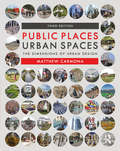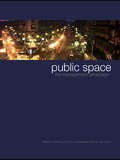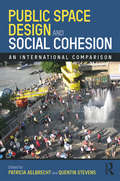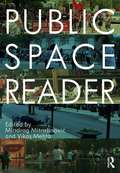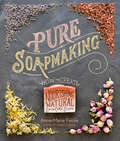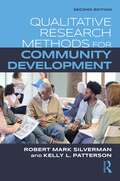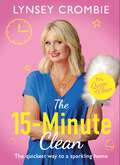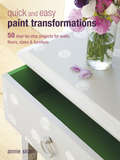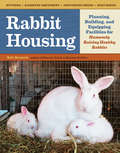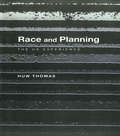- Table View
- List View
Public Places Urban Spaces: The Dimensions of Urban Design
by Matthew CarmonaPublic Places Urban Spaces provides a comprehensive overview of the principles, theory and practices of urban design for those new to the subject and for those requiring a clear and systematic guide. In this new edition the book has been extensively revised and restructured. Carmona advances the idea of urban design as a continuous process of shaping places, fashioned in turn by shifting global, local and power contexts. At the heart of the book are eight key dimensions of urban design theory and practice—temporal, perceptual, morphological, visual, social, functional—and two new process dimensions—design governance and place production. This extensively updated and revised third edition is more international in its scope and coverage, incorporating new thinking on technological impact, climate change adaptation, strategies for urban decline, cultural and social diversity, place value, healthy cities and more, all illustrated with nearly 1,000 carefully chosen images. Public Places Urban Spaces is a classic urban design text, and everyone in the field should own a copy.
Public Places Urban Spaces: The Dimensions of Urban Design
by Matthew CarmonaPublic Places Urban Spaces provides a comprehensive overview of the principles, theory and practices of urban design for those new to the subject and for those requiring a clear and systematic guide. In this new edition the book has been extensively revised and restructured. Carmona advances the idea of urban design as a continuous process of shaping places, fashioned in turn by shifting global, local and power contexts. At the heart of the book are eight key dimensions of urban design theory and practice—temporal, perceptual, morphological, visual, social, functional—and two new process dimensions—design governance and place production. This extensively updated and revised third edition is more international in its scope and coverage, incorporating new thinking on technological impact, climate change adaptation, strategies for urban decline, cultural and social diversity, place value, healthy cities and more, all illustrated with nearly 1,000 carefully chosen images. Public Places Urban Spaces is a classic urban design text, and everyone in the field should own a copy.
Public Places - Urban Spaces
by Tim Heath Taner Oc Steve TiesdellPublic Places Urban Spaces, 2e, is a thorough introduction to the principles of urban design theory and practice. Authored by experts in the fields of urban design and planning, it is designed specifically for the 2,500 postgraduate students on Urban Design courses in the UK, and 1,500 students on undergraduate courses in the same subject.The 2e of this tried and trusted textbook has been updated with relevant case studies to show students how principles have been put into practice. The book is now in full color and in a larger format, so students and lecturers get a much stronger visual package and easy-to-use layout, enabling them to more easily practically apply principles of urban design to their projects.Sustainability is the driving factor in urban regeneration and new urban development, and the new edition is focused on best sustainable design and practice. Public Places Urban Spaces is a must-have purchase for those on urban design courses and for professionals who want to update and refresh their knowledge.
Public Places - Urban Spaces
by Tim Heath Taner Oc Steve TiesdellPublic Places Urban Spaces, 2e, is a thorough introduction to the principles of urban design theory and practice. Authored by experts in the fields of urban design and planning, it is designed specifically for the 2,500 postgraduate students on Urban Design courses in the UK, and 1,500 students on undergraduate courses in the same subject.The 2e of this tried and trusted textbook has been updated with relevant case studies to show students how principles have been put into practice. The book is now in full color and in a larger format, so students and lecturers get a much stronger visual package and easy-to-use layout, enabling them to more easily practically apply principles of urban design to their projects.Sustainability is the driving factor in urban regeneration and new urban development, and the new edition is focused on best sustainable design and practice. Public Places Urban Spaces is a must-have purchase for those on urban design courses and for professionals who want to update and refresh their knowledge.
Public Space: The Management Dimension
by Matthew Carmona Claudio De Magalhães Leo HammondIn both the UK and the US there is a sense of dissatisfaction and pessimism about the state of urban environments, particularly with the quality of everyday public spaces. Explanations for this have emphasized the poor quality of design that characterizes many new public spaces; spaces that are dominated by parking, roads infrastructure, introspective buildings, a lack of enclosure and a poor sense of place, and which in different ways for different groups are too often exclusionary. Yet many well designed public spaces have also experienced decline and neglect, as the services and activities upon which the continuing quality of those spaces have been subject to the same constraints and pressures for change as public services in general. These issues touch upon the daily management of public space, that is, the coordination of the many different activities that constantly define and redefine the characteristics and quality of public space. This book draws on three empirical projects to examine the questions of public space management on an international stage. They are set within a context of theoretical debates about public space, its history, contemporary patterns of use and changing nature in western society, and about the new management approaches that are increasingly being adopted.
Public Space: The Management Dimension
by Matthew Carmona Claudio De Magalhães Leo HammondIn both the UK and the US there is a sense of dissatisfaction and pessimism about the state of urban environments, particularly with the quality of everyday public spaces. Explanations for this have emphasized the poor quality of design that characterizes many new public spaces; spaces that are dominated by parking, roads infrastructure, introspective buildings, a lack of enclosure and a poor sense of place, and which in different ways for different groups are too often exclusionary. Yet many well designed public spaces have also experienced decline and neglect, as the services and activities upon which the continuing quality of those spaces have been subject to the same constraints and pressures for change as public services in general. These issues touch upon the daily management of public space, that is, the coordination of the many different activities that constantly define and redefine the characteristics and quality of public space. This book draws on three empirical projects to examine the questions of public space management on an international stage. They are set within a context of theoretical debates about public space, its history, contemporary patterns of use and changing nature in western society, and about the new management approaches that are increasingly being adopted.
Public Space: notes on why it matters, what we should know, and how to realize its potential
by Vikas MehtaPublic Space: notes on why it matters, what we should know, and how to realize its potential journeys a vast territory and presents a panoramic view of public space—an understanding from numerous disciplines—under one cover in an incisive and concise manner. As a dialogue between the social-political and the material-physical, the book brings together the key ideas that encompass the social, political, and physical issues in the making and experience of public space. The book is at the same time a primer and a progressive text. It makes the case for public space, digs deep into understanding what public space is, followed by three sections that present the inherent paradoxes, the possibilities, and propositions for a more meaningful public space. The book presents ideas in concise and approachable ways—from established tenets to new propositions—that are constructive and thought-provoking, with many that will challenge the reader’s preconceived notions. Students and scholars in the built environment disciplines and social sciences, public space managers, public and private sector practitioners, and civic leaders, but also residents who want to better understand and make an impact in their communities and cities will find Public Space to be a valuable resource.
Public Space: notes on why it matters, what we should know, and how to realize its potential
by Vikas MehtaPublic Space: notes on why it matters, what we should know, and how to realize its potential journeys a vast territory and presents a panoramic view of public space—an understanding from numerous disciplines—under one cover in an incisive and concise manner. As a dialogue between the social-political and the material-physical, the book brings together the key ideas that encompass the social, political, and physical issues in the making and experience of public space. The book is at the same time a primer and a progressive text. It makes the case for public space, digs deep into understanding what public space is, followed by three sections that present the inherent paradoxes, the possibilities, and propositions for a more meaningful public space. The book presents ideas in concise and approachable ways—from established tenets to new propositions—that are constructive and thought-provoking, with many that will challenge the reader’s preconceived notions. Students and scholars in the built environment disciplines and social sciences, public space managers, public and private sector practitioners, and civic leaders, but also residents who want to better understand and make an impact in their communities and cities will find Public Space to be a valuable resource.
Public Space Design and Social Cohesion: An International Comparison
by Patricia Aelbrecht Quentin StevensSocial cohesion is often perceived as being under threat from the increasing cultural and economic differences in contemporary cities and the increasing intensity of urban life. Public space, in its role as the main stage for social interactions between strangers, clearly plays a role in facilitating or limiting opportunities for social cohesion. But what exactly is social cohesion, how is it experienced in the public realm, and what role can the design of city spaces have in supporting or promoting it? There are significant knowledge gaps between the social sciences and design disciplines and between academia and practice, and thus a dispersed knowledge base that currently lacks nuanced insight into how urban design contributes to social integration or segregation. This book brings together scholarly knowledge at the intersection of public space design and social cohesion. It is based on original scholarly research and a depth of urban design practice, and analyses case studies from a variety of cities and cultures across the Global North and Global South. Its interdisciplinary, cross-cultural analysis will be of interest to academics, students, policymakers and practitioners engaged with a range of subject areas, including urban design, urban planning, architecture, landscape, cultural studies, human geography, social policy, sociology and anthropology. It will also have significant appeal to a wider non-academic readership, given its topical subject matter.
Public Space Design and Social Cohesion: An International Comparison
by Patricia Aelbrecht Quentin StevensSocial cohesion is often perceived as being under threat from the increasing cultural and economic differences in contemporary cities and the increasing intensity of urban life. Public space, in its role as the main stage for social interactions between strangers, clearly plays a role in facilitating or limiting opportunities for social cohesion. But what exactly is social cohesion, how is it experienced in the public realm, and what role can the design of city spaces have in supporting or promoting it? There are significant knowledge gaps between the social sciences and design disciplines and between academia and practice, and thus a dispersed knowledge base that currently lacks nuanced insight into how urban design contributes to social integration or segregation. This book brings together scholarly knowledge at the intersection of public space design and social cohesion. It is based on original scholarly research and a depth of urban design practice, and analyses case studies from a variety of cities and cultures across the Global North and Global South. Its interdisciplinary, cross-cultural analysis will be of interest to academics, students, policymakers and practitioners engaged with a range of subject areas, including urban design, urban planning, architecture, landscape, cultural studies, human geography, social policy, sociology and anthropology. It will also have significant appeal to a wider non-academic readership, given its topical subject matter.
Public Space Reader
by Miodrag Mitrasinovi 263 Vikas MehtaRecent global appropriations of public spaces through urban activism, public uprising, and political protest have brought back democratic values, beliefs, and practices that have been historically associated with cities. Given the aggressive commodification of public re- sources, public space is critically important due to its capacity to enable forms of public dis- course and social practice which are fundamental for the well-being of democratic societies. Public Space Reader brings together public space scholarship by a cross-disciplinary group of academics and specialists whose essays consider fundamental questions: What is public space and how does it manifest larger cultural, social, and political processes? How are public spaces designed, socially and materially produced, and managed? How does this impact the nature and character of public experience? What roles does it play in the struggles for the just city, and the Right to The City? What critical participatory approaches can be employed to create inclusive public spaces that respond to the diverse needs, desires, and aspirations of individuals and communities alike? What are the critical global and comparative perspectives on public space that can enable further scholarly and professional work? And, what are the futures of public space in the face of global pandemics, such as COVID-19? The readers of this volume will be rewarded with an impressive array of perspectives that are bound to expand critical understanding of public space.
Public Space Reader
by Mitrašinović Miodrag Mehta VikasRecent global appropriations of public spaces through urban activism, public uprising, and political protest have brought back democratic values, beliefs, and practices that have been historically associated with cities. Given the aggressive commodification of public re- sources, public space is critically important due to its capacity to enable forms of public dis- course and social practice which are fundamental for the well-being of democratic societies. Public Space Reader brings together public space scholarship by a cross-disciplinary group of academics and specialists whose essays consider fundamental questions: What is public space and how does it manifest larger cultural, social, and political processes? How are public spaces designed, socially and materially produced, and managed? How does this impact the nature and character of public experience? What roles does it play in the struggles for the just city, and the Right to The City? What critical participatory approaches can be employed to create inclusive public spaces that respond to the diverse needs, desires, and aspirations of individuals and communities alike? What are the critical global and comparative perspectives on public space that can enable further scholarly and professional work? And, what are the futures of public space in the face of global pandemics, such as COVID-19? The readers of this volume will be rewarded with an impressive array of perspectives that are bound to expand critical understanding of public space.
Pure Soapmaking: How to Create Nourishing, Natural Skin Care Soaps
by Anne-Marie FaiolaThe pure luxury of soaps made with coconut butter, almond oil, aloe vera, oatmeal, and green tea is one of life&’s little pleasures. And with the help of Anne-Marie Faiola, author of Soap Crafting and Milk Soaps, it&’s easy to make luscious, all-natural soaps right in your own kitchen. This collection of 32 recipes ranges from simple castile bars to intricate swirls, embeds, and marbled and layered looks. Begin with a combination of skin-nourishing oils and then add blueberry puree, dandelion-infused water, almond milk, coffee grounds, mango and avocado butters, black tea, or other delicious ingredients — and then scent your soap with pure essential oils. Step-by-step photography guides you through every stage of cold-process soapmaking.
Put 'em Up! Fruit: A Preserving Guide & Cookbook: Creative Ways to Put 'em Up, Tasty Ways to Use 'em Up
by Sherri Brooks VintonThis creative cookbook will inspire you to not only preserve summer&’s fruit harvest, but use your homemade jams, jellies, and conserves in a host of sweet and savory dishes. Whip up a batch of peach jam and marinate shrimp kabobs in it overnight, or suspend grapefruit in lavender honey for an enticing custard topping. The flavors are fresh and contemporary and the instructions are thorough and easy to follow. Putting up — and serving up — the harvest has never been so delicious.
Qualitative Analysis for Planning & Policy: Beyond the Numbers
by John GaberThe revised and updated second edition of Qualitative Analysis for Planning & Policy is a roadmap to help planners access qualitative data and integrate it into their planning investigations. Planning and policy decisions are not based solely on numbers, and this book equips planners with a how-to guide to see what has been missing "between the lines" of quantitative data and make good decisions using the best possible information. Each chapter offers step-by-step instruction on how to set up and enact diverse types of qualitative research, and case studies demonstrate how qualitative research techniques can be combined with quantitative methods to tackle complex real-world projects. For over a decade Qualitative Analysis for Planning & Policy has been an indispensable resource for students and researchers, experienced and novice planners. The revised second edition offers myriad tools to help twenty-first-century planners make intelligent decisions, including new qualitative research techniques, technological innovations, and contemporary case studies.
Qualitative Analysis for Planning & Policy: Beyond the Numbers
by John GaberThe revised and updated second edition of Qualitative Analysis for Planning & Policy is a roadmap to help planners access qualitative data and integrate it into their planning investigations. Planning and policy decisions are not based solely on numbers, and this book equips planners with a how-to guide to see what has been missing "between the lines" of quantitative data and make good decisions using the best possible information. Each chapter offers step-by-step instruction on how to set up and enact diverse types of qualitative research, and case studies demonstrate how qualitative research techniques can be combined with quantitative methods to tackle complex real-world projects. For over a decade Qualitative Analysis for Planning & Policy has been an indispensable resource for students and researchers, experienced and novice planners. The revised second edition offers myriad tools to help twenty-first-century planners make intelligent decisions, including new qualitative research techniques, technological innovations, and contemporary case studies.
Qualitative Research Methods for Community Development
by Robert Mark Silverman Kelly PattersonThe second edition of Qualitative Research Methods for Community Development teaches the basic skills, tools, and methods of qualitative research with special attention to the needs of community practitioners. This book teaches students entering planning, community development, nonprofit management, social work, and similar applied fields the core skills necessary to conduct systematic research designed to empower communities and promote social change.Focusing on the basic elements of qualitative research, such as field observation, interviewing, focus groups, and content analysis, this second edition of this book provides an overview of core methods and theoretical underpinnings of successful research. It also includes two new chapters on qualitative data analysis software and techniques for conducting online qualitative interviews and focus groups.From housing, community organizing, neighborhood planning, and urban revitalization, this book gives students the skills they need to undertake their own projects and provides professionals a valuable reference for their future research. This book serves as a primary text for courses in applied qualitative research and as a reference book for professionals and community-based researchers.
Qualitative Research Methods for Community Development
by Robert Mark Silverman Kelly PattersonThe second edition of Qualitative Research Methods for Community Development teaches the basic skills, tools, and methods of qualitative research with special attention to the needs of community practitioners. This book teaches students entering planning, community development, nonprofit management, social work, and similar applied fields the core skills necessary to conduct systematic research designed to empower communities and promote social change.Focusing on the basic elements of qualitative research, such as field observation, interviewing, focus groups, and content analysis, this second edition of this book provides an overview of core methods and theoretical underpinnings of successful research. It also includes two new chapters on qualitative data analysis software and techniques for conducting online qualitative interviews and focus groups.From housing, community organizing, neighborhood planning, and urban revitalization, this book gives students the skills they need to undertake their own projects and provides professionals a valuable reference for their future research. This book serves as a primary text for courses in applied qualitative research and as a reference book for professionals and community-based researchers.
Queen of Clean - The 15-Minute Clean: The quickest way to a sparkling home
by Lynsey CrombieThe perfect guide to speedy cleaning from TV's Queen of Clean!Cleaning has never been quicker and easier than with Lynsey Crombie's 15-Minute Clean.No more mess, no more hours of chores on the weekend – just one 15-minute session per day that you will power through in a flash – leaving you to put your feet up. Once you adopt the 15-Minute Clean, you'll never look back.• Declutter and organize your home without a fuss• Create more time for loved ones• Relax in a tidy and calming environment• Never spend a weekend on chores again!
Quick and Easy Paint Transformations: 50 step-by-step ways to makeover your home for next to nothing
by Annie SloanWith this book in one hand and a brush in the other, you can learn how to create different finishes and effects with paint to change everyday rooms and furnishings into something special, all for the price of a pot of paint. The first section of the book tells you everything you need to know before you start - how to prepare surfaces properly, choose the right paint for the right place, use the best tools and select a colour scheme that will work with the room in question. 50 different techniques follow, with step-by-step photos showing you how to achieve the finished look, accompanied by inspirational photos showing the effect used on walls and doors, furniture and floors. Learn how to update old secondhand furniture, or how to give modern pieces a softly-aged appearance, all with the aid of a pot of paint and a brush. Whatever the style of your interiors, Quick and Easy Paint Transformations will show you the best way to makeover your home.By leading the decorative painting revolution over the last 20 years, Annie Sloan has become perhaps the world's most respected expert in decorative paint, colours, and techniques. Alongside her unique and versatile decorative paint, Chalk Paint, Annie has inspired generations with her accessible, lively, and creative approach to getting great results.
Quilts from the Country: Patchwork projects to decorate your home
by null Stuart HillardA seasonal collection of quilts inspired by life in the countryside. With twenty new projects that are suitable for a range of skill levels and include: 12 large quilts and 8 smaller items, which can be customised to suit your own décor. A brand new collection of quilts and projects from one of the most recognisable and best-loved quilt designers in the UK. These inspiring designs, photographed in beautiful rural locations, reflect the changing seasons and beauty of the British countryside. Each of the four chapters features inspirational lifestyle photography showing the quilts in beautifully styled settings. For all skill levels from beginner to advanced, the book includes the guidance and practical knowledge you need to begin quilting successfully. The 12 large quilts and 8 smaller projects and accessories can also be made in alternative colours and fabrics to fit your own style, making them enormously versatile. This is the book for any quilter and lover of country style.
Quinces: Growing and Cooking (English Kitchen #16)
by Jane McMorland Hunter Sue DunsterQuinces have become an undeservedly forgotten fruit. This book reintroduces them, making them more accessible and providing an inviting range of recipes. The trees do not require much space, and are easy to grow. The fruits are delicious and versatile and the recipes here extend well beyond jellies and jams, including sweets. From Goat's Cheese Tart to Quince Chocolates and Liqueurs, there is something for everyone. The quince has always had a special place among the fruits of Europe. The ancient Greeks called it the 'golden apple', the Romans the 'honey apple'. And it was most likely a quince, not an apple, that Eve plucked from the tree in the Garden of Eden. This book describes both the cultivation, the history and the cooking of quinces. There is a sketch of the glorious history of the fruit in cookery of past ages; there are some excellent recipes for savoury dishes that depend on the quince for that special flavour, and for all those sweet dishes that bring out the unique qualities of the fruit.We tend to forget that the first marmalades were made from quinces.
Rabbit Housing: Planning, Building, and Equipping Facilities for Humanely Raising Healthy Rabbits
by Bob BennettPlans for designing and building efficient facilities for sheltering backyard rabbits in safety and comfort, whether it's just two or as many as one hundred.
Race and Planning: The UK Experience
by Huw ThomasDrawing on a number of research studies of planning and urban policy, ace and Planning asks why racial equality has not been higher on professional and government agendas, and suggests strategies for those working on change. It considers key issues such as how planning activities might lead to more emphasis on the significance of racial equality; might currently it be unwittingly underpinning racial disadvantage? Alternatively, can planning help challenge racism and promote equal opportunities? The book's arguments are sensitive to the rapidly changing focus of the politics of race including: 'fortress Europe', Macpherson and modernism.
Race and Planning: The UK Experience
by Huw ThomasDrawing on a number of research studies of planning and urban policy, ace and Planning asks why racial equality has not been higher on professional and government agendas, and suggests strategies for those working on change. It considers key issues such as how planning activities might lead to more emphasis on the significance of racial equality; might currently it be unwittingly underpinning racial disadvantage? Alternatively, can planning help challenge racism and promote equal opportunities? The book's arguments are sensitive to the rapidly changing focus of the politics of race including: 'fortress Europe', Macpherson and modernism.
